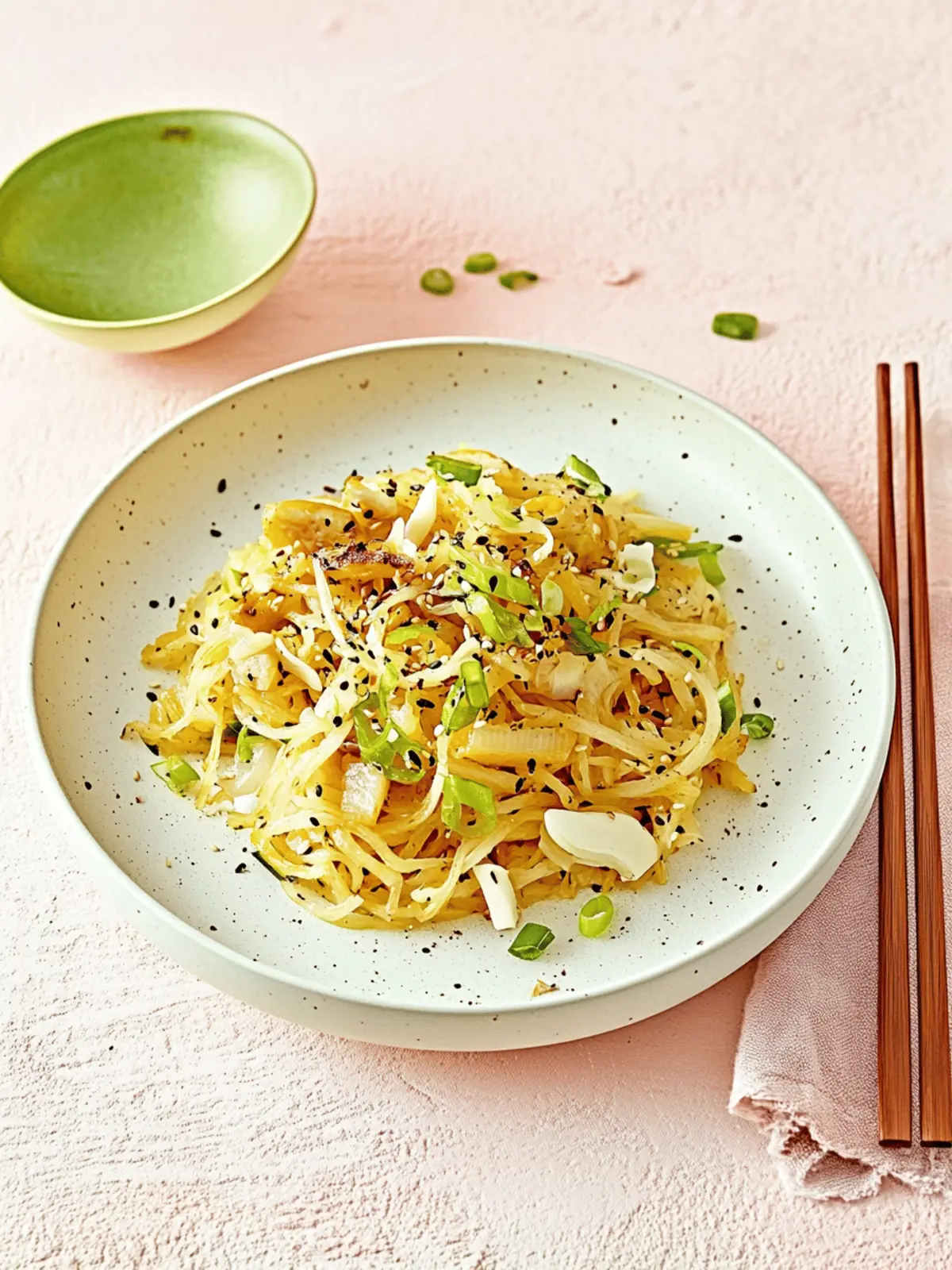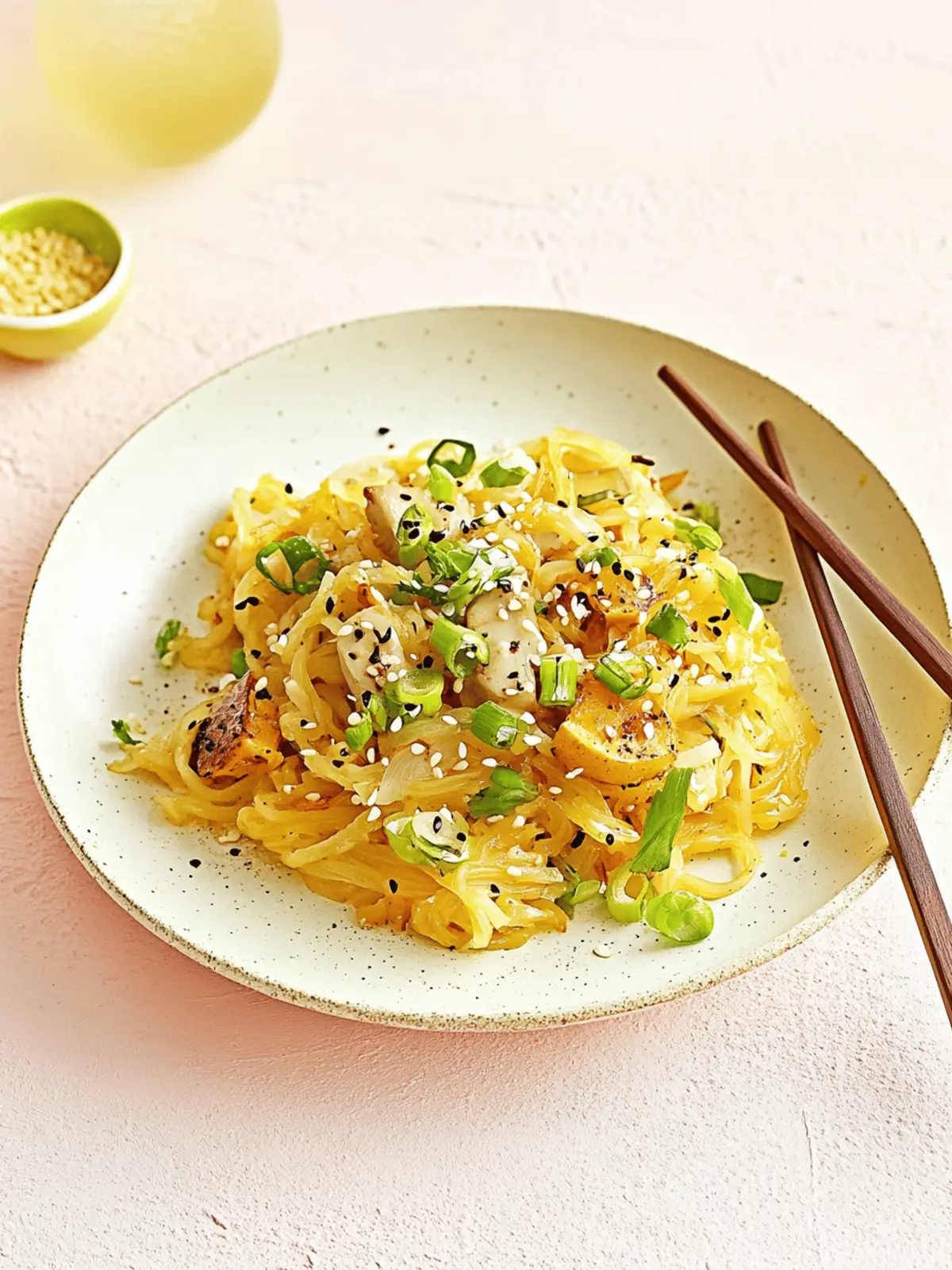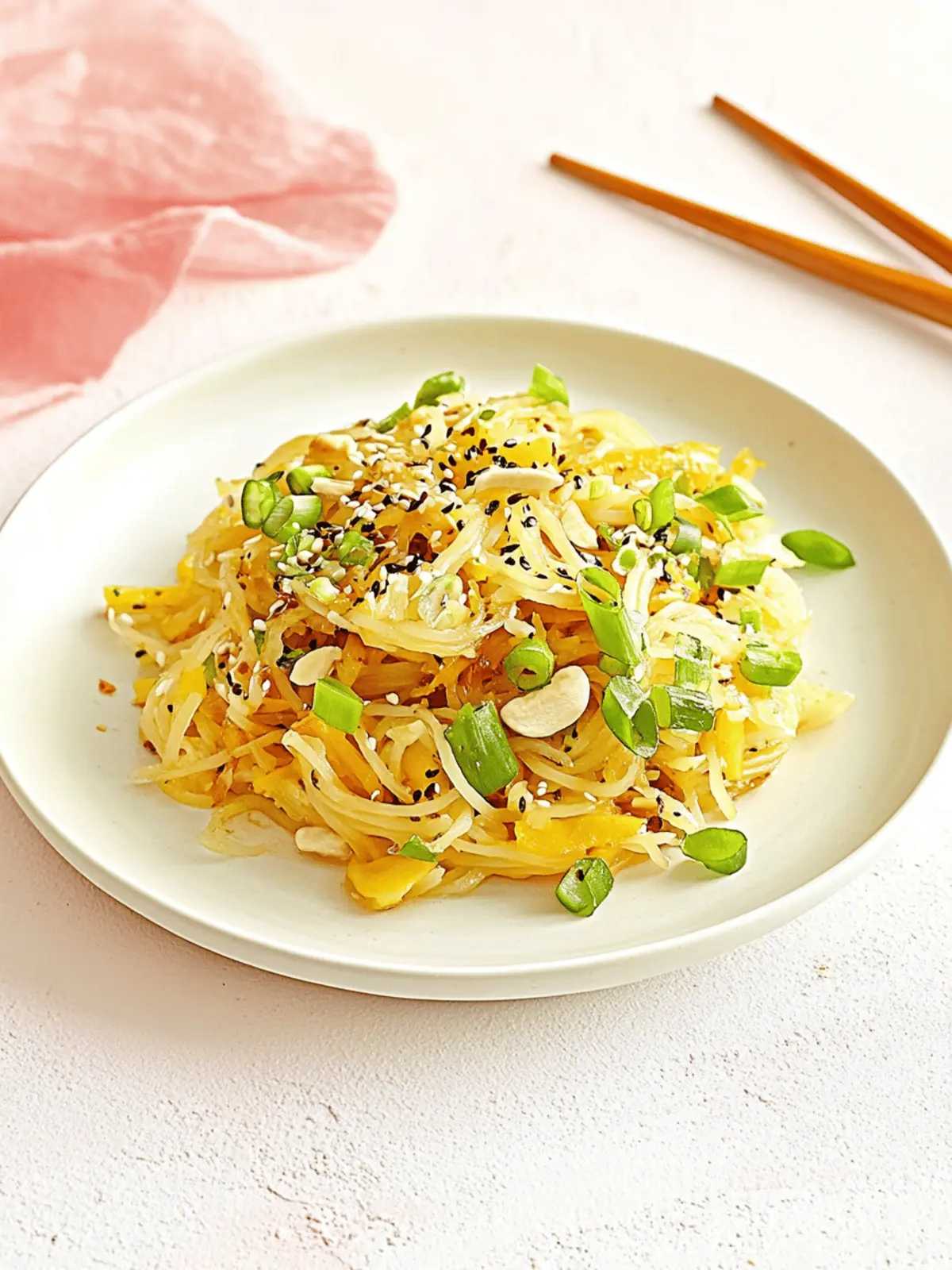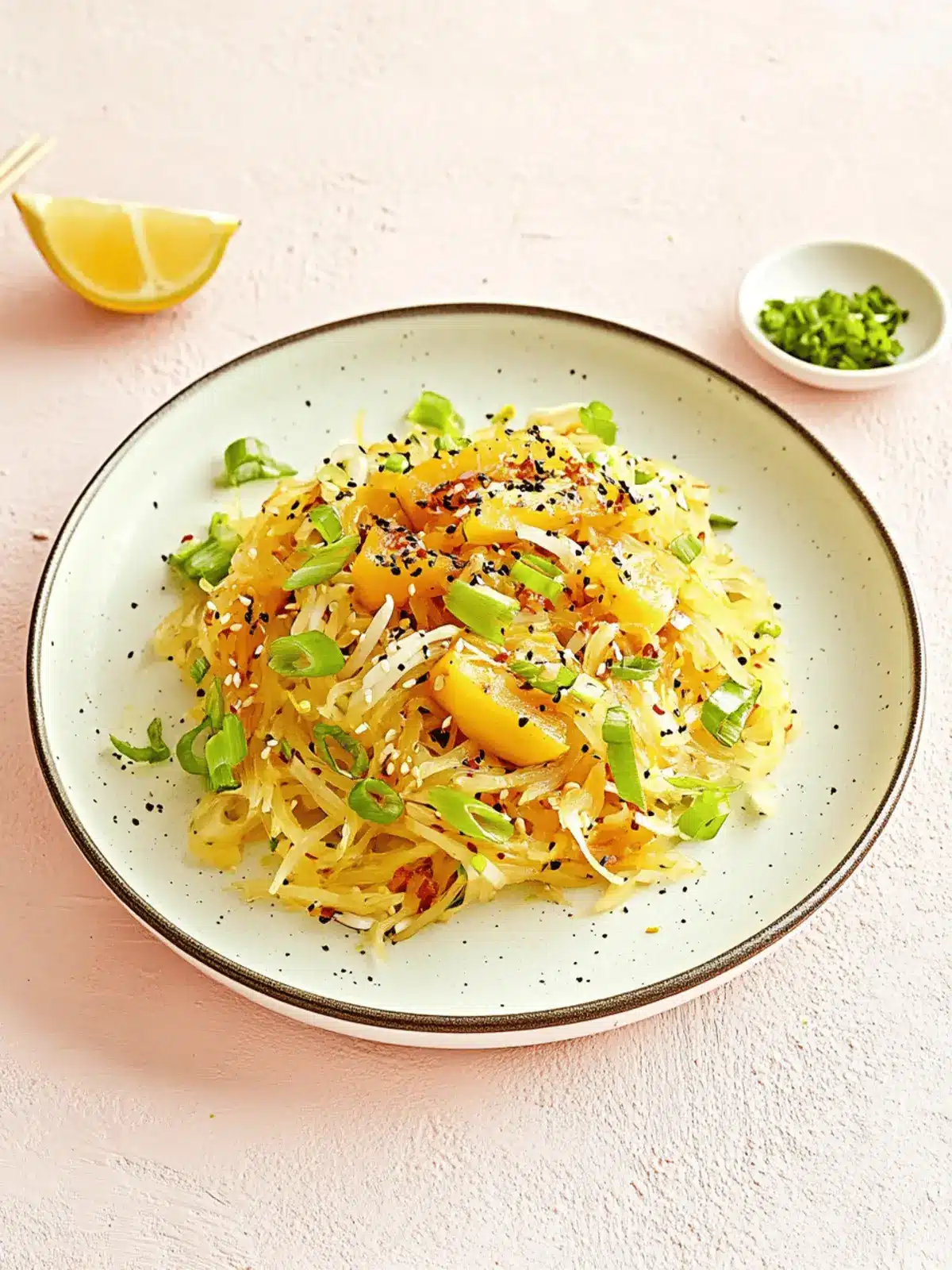The moment I swapped my traditional noodles for spaghetti squash in a bustling weeknight kitchen, I knew I’d stumbled upon something truly special. This Gluten-Free Vegan Spaghetti Squash Chow Mein takes the essence of a beloved comfort dish and adds a fresh, healthful twist. Imagine the delightful aroma of sautéed garlic and ginger wafting through your home, blending perfectly with vibrant veggies, all enveloped in a savory sauce. It’s not just a meal; it’s a celebration of flavor and color on your plate.
When I first tried this recipe, I was amazed at how easily the spaghetti squash mimics the texture of classic noodles while being so much lighter. Whether you’re looking for a quick dinner solution or a stunning side dish for your next gathering, this adaptable recipe checks all the boxes. Plus, it beautifully balances nutrition and satisfaction, making it perfect for those of us seeking a break from fast food or simply craving something wholesome. Let’s dive into this delightful culinary adventure!
Why is Spaghetti Squash Chow Mein a Must-Try?
Deliciously Unique: This recipe transforms the traditional chow mein into a gluten-free and vegan delight, bringing new life to a classic favorite.
Savory Flavor: The combination of garlic, ginger, and toasted sesame oil creates an aromatic base that elevates every bite.
Versatile Dish: Enjoy it as a hearty main or a vibrant side; it fits effortlessly into any meal plan.
Quick Prep: With minimal cooking time, you can whip this up in under 30 minutes, perfect for busy weeknights!
Healthy Twist: Low in calories and high in fiber, it’s a guilt-free indulgence that makes you feel good inside and out.
Treat yourself to this delightful dish and experience the joy of making healthier choices without sacrificing flavor!
Ingredients for Spaghetti Squash Chow Mein
• Discover everything you need to create this delicious twist on a classic dish.
For the Chow Mein
- Spaghetti Squash – Provides the noodle base for the dish; you can substitute with zucchini noodles if desired.
- Low Sodium Soy Sauce – Adds essential umami flavor; opt for tamari to keep it gluten-free.
- Garlic (3 cloves, grated) – Brings aromatic depth; fresh garlic is preferred, but powdered can work in a pinch.
- Toasted Sesame Oil (½ tablespoon) – Enhances richness and adds a nutty aroma; substitute with olive oil if there’s a sesame allergy.
- Maple Syrup/Agave Nectar (1 tablespoon) – Balances flavors with a touch of sweetness; honey is a great alternative for non-vegans.
- Fresh Ginger (3 teaspoons, grated) – Adds warmth and spice; fresh ginger enhances flavor much more than ground.
For the Vegetables
- Vegetable Oil (2 tablespoons) – Used for sautéing; avocado oil is a healthy substitute.
- Yellow Onion (½, diced) – Offers foundational sweetness; shallots can replace for a milder taste.
- Celery Stalks (3, sliced diagonally) – Provides crunch; green bell peppers can work if they’re handy.
- Carrots (2, julienned) – Delivers sweetness and vibrant color; zucchini is another option for variation.
- Green Cabbage (2 cups, thinly shredded) – Adds a crunchy texture; savoy cabbage is a good alternative.
- Bean Sprouts (1 cup) – Brings freshness and crunchiness; feel free to swap in snow peas for a different bite.
- Green Onion (sliced, for garnish) – Enhances presentation with its mild onion flavor; use generously for a pop of color.
Dive into these ingredients to craft your very own Spaghetti Squash Chow Mein and enjoy a fresh twist on this delightful dish!
How to Make Spaghetti Squash Chow Mein
-
Preheat the oven: Begin by preheating your oven to 375°F (190°C). While it heats, prepare your rimmed baking sheet with a spritz of nonstick cooking spray for easy cleanup.
-
Soften the squash: Use a fork to poke holes all around the spaghetti squash. Then, microwave it covered with a wet paper towel for about 8-10 minutes, until the skin is easier to handle.
-
Cut and seed: Allow the squash to cool for a few minutes before slicing it in half crosswise. Scoop out the seeds gently; this will reveal the tender flesh inside.
-
Scrape out strands: Take a fork and carefully scrape the flesh of the squash to create long, spaghetti-like strands. Set these delicate strands aside for later.
-
Whisk the sauce: In a small bowl, combine the soy sauce, grated garlic, maple syrup, ginger, and sesame oil. Whisk them together until well blended, then set aside to let the flavors meld.
-
Warm the oil: Heat vegetable oil in a large skillet over medium-high heat. Watch closely as it warms up; you want it nicely heated but not smoking.
-
Sauté the aromatics: Add diced onion, sliced celery, and julienned carrots to the skillet. Sauté for about 3-4 minutes, stirring regularly until they are tender and fragrant.
-
Add the greens: Toss in the shredded cabbage and bean sprouts into the skillet. Stir well and cook them for another 2 minutes, letting them become crisp and heated through.
-
Mix in the sauce: Pour the soy sauce mixture over the sautéed vegetables and stir thoroughly. Cook for 1 minute to allow the flavors to infuse.
-
Combine with squash: Finally, gently fold in the prepared spaghetti squash strands until they are evenly coated with the delicious sauce and mixed with the sautéed vegetables. Serve warm, smiling at the beautiful colors on your plate.
Optional: Top with sliced green onions for an extra pop of flavor and garnish!
Exact quantities are listed in the recipe card below.

Make Ahead Options
These Spaghetti Squash Chow Mein are perfect for busy home cooks looking to save time during hectic weeknights! You can prepare the spaghetti squash up to 24 hours in advance by cooking it, scraping the strands, and storing them in an airtight container in the refrigerator. Additionally, the sautéed vegetable mix can also be prepped ahead and kept for up to 3 days. When you’re ready to serve, simply reheat the vegetables in a skillet, fold in the spaghetti squash, and add your pre-whisked sauce to ensure everything is well-coated and flavorful. This way, you’ll enjoy restaurant-quality results with minimal effort, all without compromising on freshness!
What to Serve with Spaghetti Squash Chow Mein?
Enhance your meal with delightful companions that balance the flavors and textures of this vibrant dish.
-
Fresh Spring Rolls: Light and filled with crunchy vegetables, these rolls add a refreshing contrast to the warm chow mein.
-
Sesame Ginger Dressing Salad: A zesty salad tossed in a homemade sesame dressing complements the savory flavors while adding a crisp, refreshing bite.
-
Sautéed Broccoli: This nutrient-packed side, with its bright green color and tender crunch, brings a lovely earthy flavor that pairs beautifully with the chow mein.
-
Coconut Curry Soup: The creamy richness of coconut curry can provide a warm, comforting balance to the lighter chow mein, making for a cozy meal.
Savor these pairings for a delightful, multi-dimensional dining experience! Each addition enhances both the taste and visual appeal of your table.
How to Store and Freeze Spaghetti Squash Chow Mein
- Room Temperature: It’s best to serve Spaghetti Squash Chow Mein immediately after cooking for the best flavor and texture. If left out, it should not exceed 2 hours at room temperature.
- Fridge: Store leftovers in an airtight container in the refrigerator for up to 3 days. Gently reheat in a skillet or microwave, checking to avoid overcooking the vegetables.
- Freezer: For longer storage, freeze the chow mein in a freezer-safe, airtight container for up to 3 months. Thaw overnight in the fridge before reheating.
- Reheating: When ready to enjoy, reheat on the stovetop over low heat, adding a splash of water or vegetable broth to keep the dish moist and revive its freshness.
Spaghetti Squash Chow Mein Variations
Feel free to explore these delightful twists to make this dish your own! Each variation beckons with tempting flavors and textures.
- Zucchini Noodles: Swap spaghetti squash with spiralized zucchini for a lighter noodle choice.
- Chickpeas: Add protein by incorporating canned chickpeas for a hearty touch. They bring a lovely creaminess to each bite.
- Tofu Crumbles: For a substantial addition, sauté crumbled tofu until crisp and golden before mixing it in. This enhances both texture and nutrition.
- Bell Peppers: Dust off your rainbow stash! Toss in some vibrant bell peppers for a sweet crunch and beautiful hues.
- Sesame Seeds: Sprinkle toasted sesame seeds on top just before serving for an extra nutty delight and a lovely crunch.
- Fresh Herbs: Brighten up your dish with fresh cilantro or basil; they create a burst of aromatic freshness that elevates everything.
- Heat Boost: Introduce crushed red pepper flakes or Sriracha for a spicy kick, perfect for those who enjoy a little heat in their meals.
- Savoy Cabbage: Swap out regular green cabbage for savoy cabbage to enjoy a softer texture and milder flavor profile.
Experiment with these variations to create a version of Spaghetti Squash Chow Mein that’s uniquely yours!
Expert Tips for Spaghetti Squash Chow Mein
-
Poke Holes: Ensure you poke enough holes in the spaghetti squash to prevent it from bursting in the microwave.
-
Scrape Carefully: When scraping the spaghetti squash, make sure to separate the strands thoroughly for the best texture; clumps can ruin the noodle effect.
-
Adjust Cooking Time: Sauté the vegetables to your desired tenderness; some prefer a bit of crunch while others like them softer.
-
Flavor Balance: Taste your sauce mixture before adding it to the skillet; adjust with more maple syrup or soy sauce to suit your flavor preferences.
-
Keep It Fresh: If you have leftovers, store them in an airtight container in the fridge for up to 3 days; the flavors continue to improve!

Spaghetti Squash Chow Mein Recipe FAQs
How do I select the perfect spaghetti squash?
Absolutely! When selecting spaghetti squash, look for a firm squash with a smooth, golden-yellow rind. Avoid any with dark spots or soft patches, as these may indicate spoilage. A hefty squash is often a good sign of ripeness, and should feel dense when you lift it.
How can I store leftovers of the spaghetti squash chow mein?
Very! To store leftovers, place them in an airtight container and refrigerate for up to 3 days. Make sure they cool down to room temperature before sealing. When ready to reheat, you can use a microwave or a skillet over low heat to gently warm them, ensuring you don’t overcook the vegetables.
Can I freeze spaghetti squash chow mein?
Definitely! To freeze, first allow the chow mein to cool completely. Then, transfer it to a freezer-safe, airtight container or a resealable freezer bag. It can be stored in the freezer for up to 3 months. When you’re ready to enjoy it, thaw overnight in the refrigerator and reheat on the stovetop, adding a splash of vegetable broth to keep it moist and flavorful.
What should I do if my spaghetti squash doesn’t seem to separate into strands properly?
Don’t worry — it happens! If your spaghetti squash is too watery or clumpy after scraping, try cooking it longer to release more moisture. Another tip is to ensure you scrape along the grain of the squash with a fork to better create those lovely strands. If it’s still not working, remember you can always add more sautéed veggies or sauces to enhance the flavor, even if the texture isn’t perfect.
Are there any dietary considerations I should be aware of?
Absolutely! Since this recipe is vegan and gluten-free, it is perfect for many dietary preferences. However, pay attention to the soy sauce you choose — stick with low sodium and tamari to keep it gluten-free, and if you’re allergic to sesame, feel free to replace the toasted sesame oil with olive oil. Always check ingredient labels for any potential allergens based on your dietary needs.
What’s the best way to reheat my chow mein so it doesn’t get mushy?
Great question! To avoid mushiness when reheating, do it gently over low heat in a skillet. Add a splash of water or vegetable broth to keep it moist, and stir often to help maintain its texture. Heating it slowly allows the vegetables to warm up without becoming overly soft, giving you that just-cooked bite even on the second day!

Spaghetti Squash Chow Mein: A Healthy Twist on Tradition
Ingredients
Equipment
Method
- Preheat your oven to 375°F (190°C) and prepare your baking sheet with nonstick cooking spray.
- Poke holes all around the spaghetti squash and microwave it covered with a wet paper towel for about 8-10 minutes.
- Allow the squash to cool, then slice it in half crosswise and scoop out the seeds.
- Scrape the flesh of the squash with a fork to create spaghetti-like strands and set aside.
- In a small bowl, whisk together soy sauce, grated garlic, maple syrup, ginger, and sesame oil.
- Heat vegetable oil in a large skillet over medium-high heat.
- Add diced onion, sliced celery, and julienned carrots to the skillet and sauté for about 3-4 minutes.
- Toss in shredded cabbage and bean sprouts, cooking for another 2 minutes.
- Pour the soy sauce mixture over the sautéed vegetables and cook for 1 minute.
- Gently fold in the prepared spaghetti squash strands and serve warm, garnished with sliced green onions.






